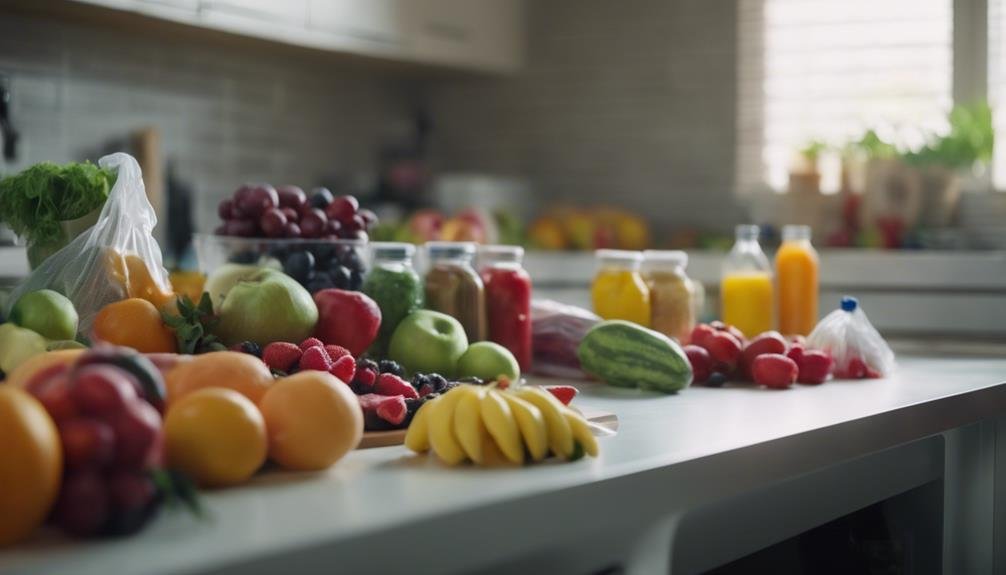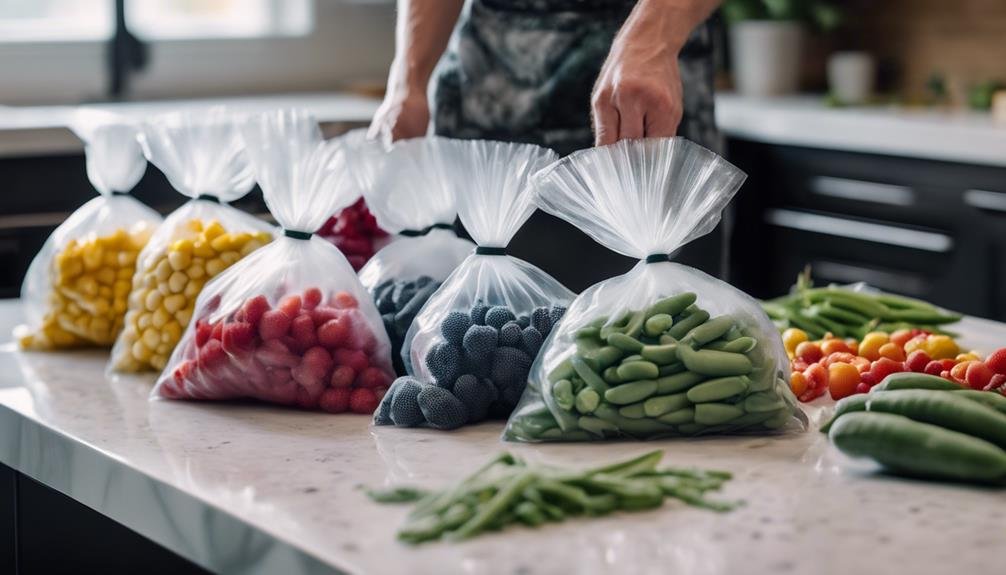When vacuum sealing seasonal produce, start by choosing ripe and fresh organic items to minimize pesticide exposure. Blanch vegetables to retain nutrients and texture, then cool them in ice water. Thoroughly dry the produce to prevent ice crystals and ensure a tight seal. Select the right vacuum sealer for your needs, whether traditional or handheld. Quick freeze the produce to minimize damage to the cells. Store the sealed bags in a cool, dry area and label them for easy organization. If you're ready for more detailed steps, let's dive in!
Choosing Fresh Produce
When you're selecting fresh produce, opt for seasonal fruits and vegetables at their peak freshness to ensure the best flavor and nutrient content. Seasonal produce isn't just tastier; it's also packed with more nutrients. Look for locally grown options to support your community and reduce your carbon footprint. Local produce often reaches you faster, ensuring it's fresher.
While shopping, check for signs of ripeness. Vibrant color, firmness, and a fresh smell are good indicators that the produce is in its prime. Don't forget to contemplate organic fruits and vegetables. Choosing organic minimizes your exposure to pesticides and chemicals, making your meals healthier.
Blanching Vegetables
Blanching vegetables is an important step to guarantee they retain their color, flavor, and nutrients when vacuum sealed and frozen. This process involves briefly boiling or steaming the vegetables to destroy harmful micro-organisms and halt enzyme activity that can cause spoilage. By blanching, you make sure that your produce maintains its quality and freshness over an extended period.
After blanching, it is vital to cool the vegetables in ice water. This immediate cooling stops the cooking process, preserving their texture and preventing them from becoming mushy when frozen. Properly blanched and cooled vegetables are less likely to suffer from freezer burn, making them ideal for long-term food preservation.
Here are three key benefits of blanching vegetables before vacuum sealing:
- Retains Nutrients: Blanching helps lock in essential vitamins and minerals.
- Prevents Freezer Burn: Properly blanched vegetables have a lower risk of developing freezer burn.
- Extends Shelf Life: This technique helps extend the shelf life of your frozen produce.
Drying Before Sealing

Why is it important to thoroughly dry your produce before vacuum sealing it? When you dry your produce before vacuum sealing, you're taking an essential step in preserving its quality. Excess moisture on fruits and vegetables can lead to the formation of ice crystals, which not only affect the texture and taste but also cause freezer burn. This can severely diminish the freshness you're trying to preserve.
You can use paper towels or a salad spinner to remove excess water from your produce. Make sure every piece is completely dry before moving on to the sealing process. Moisture left on the produce can interfere with achieving an airtight seal, which is essential for long-term storage. If the seal isn't airtight, air can seep in and compromise the preservation of your produce.
Vacuum Sealing Methods
To get the most out of vacuum sealing your seasonal produce, start by choosing the right sealing method for your needs. Different vacuum sealing methods can greatly impact how well you preserve fruits and vegetables, helping you extend their shelf life effectively.
First, consider the traditional vacuum sealer. This device removes air from specially designed bags, sealing your produce in an airtight environment. For delicate fruits and vegetables, use the pulse setting to avoid crushing them. Another option is the chamber vacuum sealer, which is ideal for liquid-rich foods and ensures a more robust seal by removing air from both the bag and the chamber.
Here are some key points to remember when selecting your method:
- Traditional Vacuum Sealer: Best for everyday use and most fruits and vegetables.
- Chamber Vacuum Sealer: Great for liquid-rich items and bulk sealing.
- Handheld Vacuum Sealer: Portable and convenient for smaller quantities.
Incorporate the blanching process before sealing vegetables to further extend shelf life and retain nutrients. Proper sealing techniques will save time and reduce food waste, allowing you to enjoy seasonal produce year-round. By understanding these methods, you'll make the most out of your vacuum sealing efforts.
Freezing Techniques

When freezing seasonal produce, make sure it's completely dry before vacuum sealing to prevent ice crystals and freezer burn. Freezing fruits like berries or peaches involves spreading them out on a baking sheet first to freeze individually before transferring them into vacuum seal bags. This way, they won't clump together, making it easier to use just what you need later.
For vegetables, blanching is essential. Blanch vegetables such as green beans by boiling them briefly, then plunging them into ice water. This process helps preserve their color, flavor, and nutrients. Once blanched and dried, place them in vacuum seal bags. Using vacuum sealers ensures that the bags are airtight, extending the shelf life of your produce.
Quick freezing at colder temperatures is key to minimizing cell wall damage in both fruits and vegetables. After sealing and freezing, label and date each bag. This step helps you track freshness and organize meal planning efficiently. By following these freezing techniques, you'll be able to enjoy the taste and nutritional benefits of seasonal produce all year round. Vacuum sealing truly makes extending its shelf life simple and effective.
Storage Best Practices
Storing vacuum-sealed seasonal produce in a cool, dry place is essential for maintaining its freshness and quality. After investing time in blanching, flash freezing, and vacuum sealing your seasonal fruits and vegetables, you need to make sure they're stored properly to maximize their shelf life. A pantry, basement, or even a dedicated storage room can be ideal locations.
Use your vacuum sealer to create airtight bags that protect your food from moisture and air, which are the main culprits of spoilage. When placing your vacuum-sealed bags in storage, it's important to label and date each package. This helps you keep track of what you have and when it needs to be used, making meal planning more efficient.
- Organize by type: Separate fruits from vegetables for easy access.
- Rotate stock: Use older sealed bags first to ensure nothing goes to waste.
- Check regularly: Inspect your storage area for any signs of moisture or pests.
Conclusion
You've now got the tools to turn your kitchen into a time machine, preserving the vibrant flavors of each season! By choosing the freshest produce, blanching and drying it right, and mastering vacuum sealing methods, you're all set. Pop those treasures into the freezer and follow best storage practices. When winter's chill bites, you'll have a taste of summer sunshine at your fingertips. So, roll up your sleeves and let the vacuum sealing adventure begin!
